Planning a Utah national parks road trip? I’ve got the ultimate Utah itinerary, based on my own travels in this beautiful state. And to make your planning easier, I’ve even included a handy downloadable trip planner!
With five national parks to explore, hiking trails galore and some epic scenery, a Utah national parks road trip is something you’ll never forget.
Hitting the so-called Mighty 5 – Utah’s five national parks of Zion, Bryce Canyon, Arches, Canyonlands and Capitol Reef – is possible in just a week, and you won’t believe how different and beautiful each national park is.
Here I’m sharing the Utah road trip itinerary my husband and I took. This itinerary allowed us to see the Mighty 5 in just seven days – and we even snuck in a quick side trip to Arizona.
This is one of my favourite adventures of all time in the United States, so here’s how you can follow the Utah itinerary we took.
I’ve even created a printable planner so that you can plot out your own Utah national parks road trip itinerary, so download a copy here.
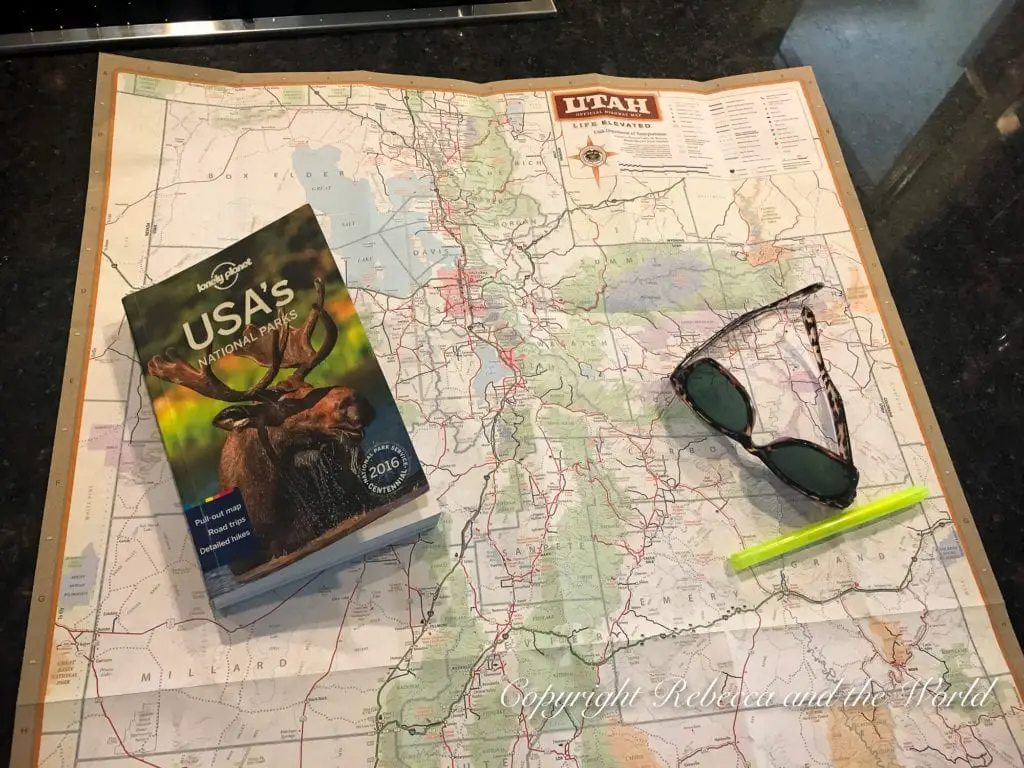
This blog post may contain affiliate links, meaning if you book or buy something through one of these links, I may earn a small commission (at no extra cost to you).
How to do this Utah road trip
This is a road trip, so of course you’ll need your own wheels. You have a few options here:
- Rent a car through Discover Cars and either camp or stay at hotels/Airbnbs along the way.
- Rent a campervan or RV – this is what we did and it made the trip even more fun! You’ll combine your transport and accommodation costs, saving some dollars as well. RVShare is a good option for this; it’s like the Airbnb of RVs. Escape Campervans is another great option for campervan rentals. I’ve listed campground throughout this post and you can use apps like iOverlander or US Public Lands to find free campsites.
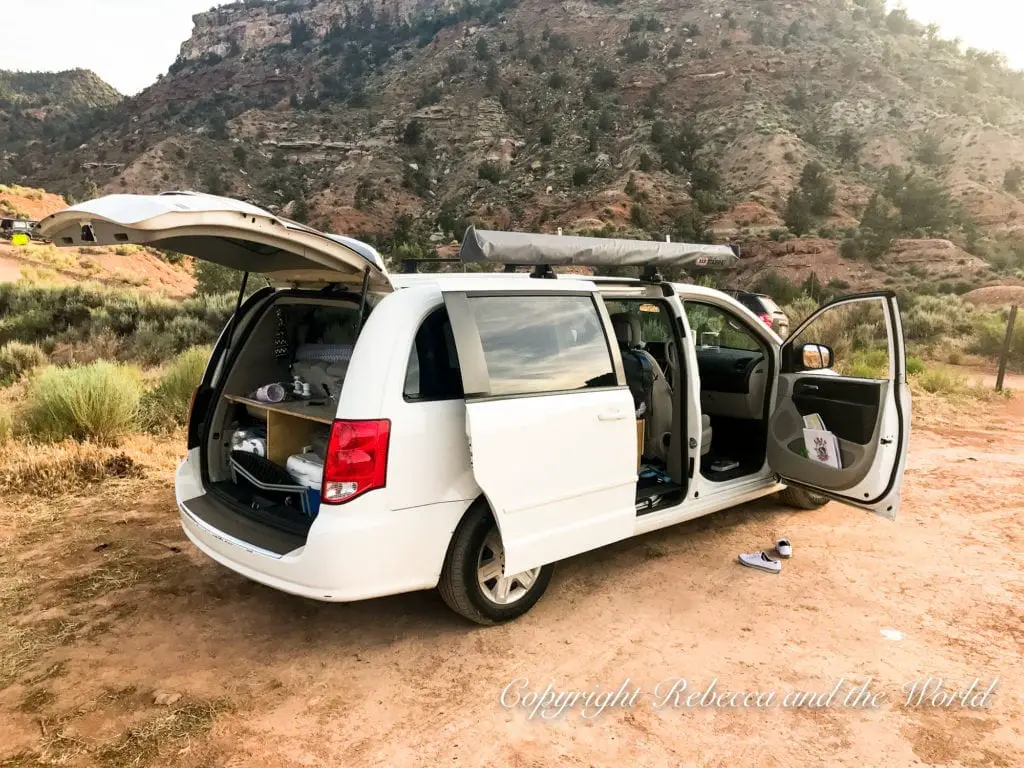
A question I get asked: Do you need a 4×4 for this road trip? If you follow this itinerary, you won’t need a 4×4 – a regular car is perfectly fine. The roads are all sealed and well maintained. Of course, you won’t be able to get out to some of the backroad locations – but you probably wouldn’t have time to do that in this short itinerary anyway.
Utah Mighty 5 road trip routes
To do this bucket list USA Utah national parks road trip, I’d recommend at least a week. This itinerary will give you a day in each park (two days in some parks) so there isn’t a lot of room for downtime.
If you have 10 days or two weeks to road trip Utah’s national parks, that would be even better. This will allow you to really explore all the natural beauty this state has to offer.
There are several ways you can visit all five Utah national parks in a week, depending on where you’re starting from. The best places to start and end this trip is in Las Vegas or Salt Lake City.
| Option 1 | Option 2 | Option 3 | |
| Day | Salt Lake City to Salt Lake City | Las Vegas to Salt Lake City (or vice versa) | Las Vegas loop |
| 1 | Salt Lake City to Zion | Las Vegas to Zion NP | Las Vegas to Zion NP |
| 2 | Zion National Park | Zion National Park | Zion NP |
| 3 | Bryce Canyon National Park | Monument Valley | Bryce Canyon NP |
| 4 | Monument Valley | Canyonlands National Park / Moab | Capitol Reef NP / Moab |
| 5 | Canyonlands National Park / Moab | Arches and Canyonlands National Park | Arches NP / Canyonlands |
| 6 | Arches and Canyonlands National Parks | Capitol Reef NP / Bryce Canyon NP | Monument Valley |
| 7 | Capitol Reef NP to Salt Lake City | Bryce Canyon to Salt Lake City | Back to Las Vegas |
We did option number 1, but if I was doing this trip again, I’d probably take the Las Vegas to Salt Lake City (or vice versa) route to save on a bit of backtracking.
For option #2, check that your rental company allows you to return a vehicle to another location (there may be an additional charge).
For option #3, you could even add in a side trip to the Grand Canyon if you have one or two extra days.
These three Utah road trip route options include a side trip into Arizona to Monument Valley. But if you’re short on time, you can cut this out of your Utah itinerary.
National parks road trip itinerary
As mentioned earlier, we did a loop starting and ending in Salt Lake City, so that’s what I’ll get into in this article. You can easily take the information here and adapt it to the alternative routes listed above.
This 7-day Utah road trip itinerary that loops from Salt Lake City is:
- Day 1: Salt Lake City to Zion National Park
- Day 2: Zion National Park
- Day 3: Bryce Canyon National Park
- Day 4: Monument Valley
- Day 5: Canyonlands National Park and Moab
- Day 6: Arches National Park and Canyonlands National Park
- Day 7: Back to Salt Lake City via Capitol Reef National Park
Map of Utah national parks
Before I get into the nitty gritty of the Utah national parks road trip itinerary, here’s a map of where you’ll be going if you follow the route we took. You can download a map of national parks in Utah on the Visit Utah website or they’ll even post one to you if you plan ahead.
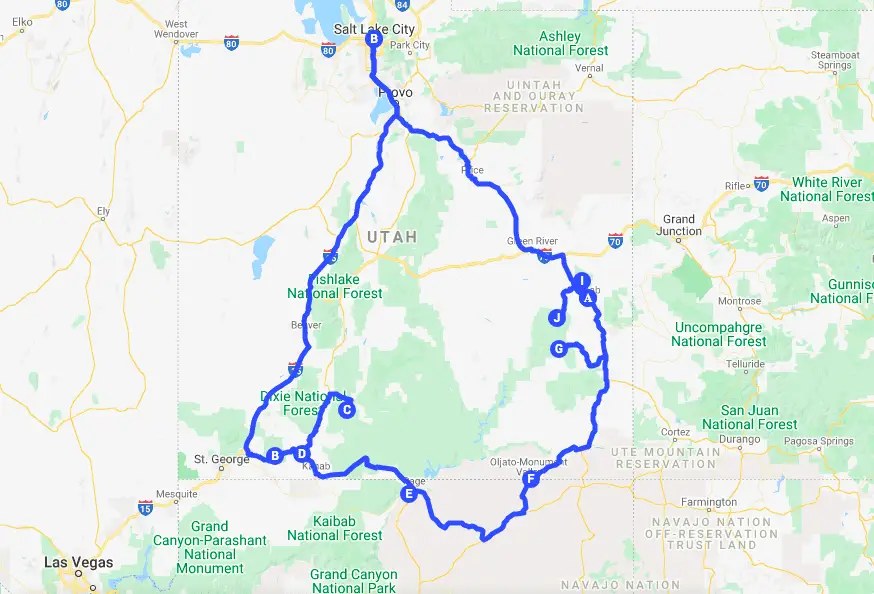
Alright, it’s time to hit the road!
Day 1: Salt Lake City to Zion National Park
Driving time: 4.5 hours / 308 miles
First up on this 7 day Utah national parks itinerary: pick up your car or campervan. Pick up any supplies you may need (including plenty of road trip snacks!). I have a handy road trip checklist so you don’t forget anything important.
You could check out of a few of the best things to do in Salt Lake City, but I’d recommend jumping straight on the road and heading for Zion National Park. It’s about a 4.5-hour drive from Salt Lake City.
Zion National Park is the busiest Utah national park, with more than 5 million visitors. Despite the crowds, it’s a must-visit on a Utah parks road trip.
Springdale is the town just outside of the entrance to Zion, and it has several great options for your first dinner on the road.
Zion National Park quick reference guide
Entrances: The main entrance is the South Entrance, near the town of Springdale
Entrance fee: Private Vehicle, $35, valid for 7 days
Website: Zion National Park
Tips: Access to cars through the park is limited during high season (March to November), but Zion National Park has a fantastic free shuttle bus system to get around. The shuttle stops at all the key trailheads and loops around fairly frequently.
There’s also a shuttle bus that links to the Zion Canyon Shuttle from Springdale, which is convenient if you’re staying in town.
Where to stay in Zion National Park
Zion National Park campgrounds
Zion National Park has three campgrounds: South, Watchman and Lava Point. You can reserve South and Watchman in advance (campsites are $20 per night, $30 for powered sites at Watchman). South Campground can be reserved up to 14 days in advance, while Watchman can be reserved up to 6 months ahead of time. (Update: As of December 2023, South Campground is partially closed for rehabilitation works.)
If you can’t get a reservation in advance, you can still plan to arrive at the campgrounds at around 10 or 11am just in case a site becomes available. That’s how we got a site for the night.
Lava Point only has six basic campsites and is more remote, with no cell reception. Reservations can be made online. It’s open May to September only.
Hotels near Zion National Park
- Zion Lodge is the only hotel inside Zion National Park
- For something partway between a hotel and camping, try the luxury, safari-style tents at Under Canvas Zion
- Cliffrose Lodge is close to the entrance to Zion National Park
- Best Western Plus Zion Canyon Inn & Suites has comfy rooms with mini fridges and coffee makers – and great views
Vacation rentals near Zion National Park
If you can’t get a hotel room, plan ahead and look at vacation rentals instead. VRBO has several options to suit all group sizes and budgets. Check vacation rentals near Zion National Park.
Day 2: Zion National Park
Wake up early (I’m talking, like, 5am) to get a head start on the Angel’s Landing hike. This hike is very popular on most people’s Zion national park itinerary, and starting early helps to avoid both the crowds and the heat of the day. It’s a beautiful but fairly strenuous hike with some pockets of shade.
The final ascent to Angel’s Landing is a narrow ridge with steel chains as the only barrier to keep you falling hundreds of metres off the side.
I’m not shy in admitting that I just couldn’t bring myself to do this final section – it was too scary for me. I stayed below while my husband did the final section. He said that it was hairy in some parts, but the views are worth it if you don’t have a fear of heights.
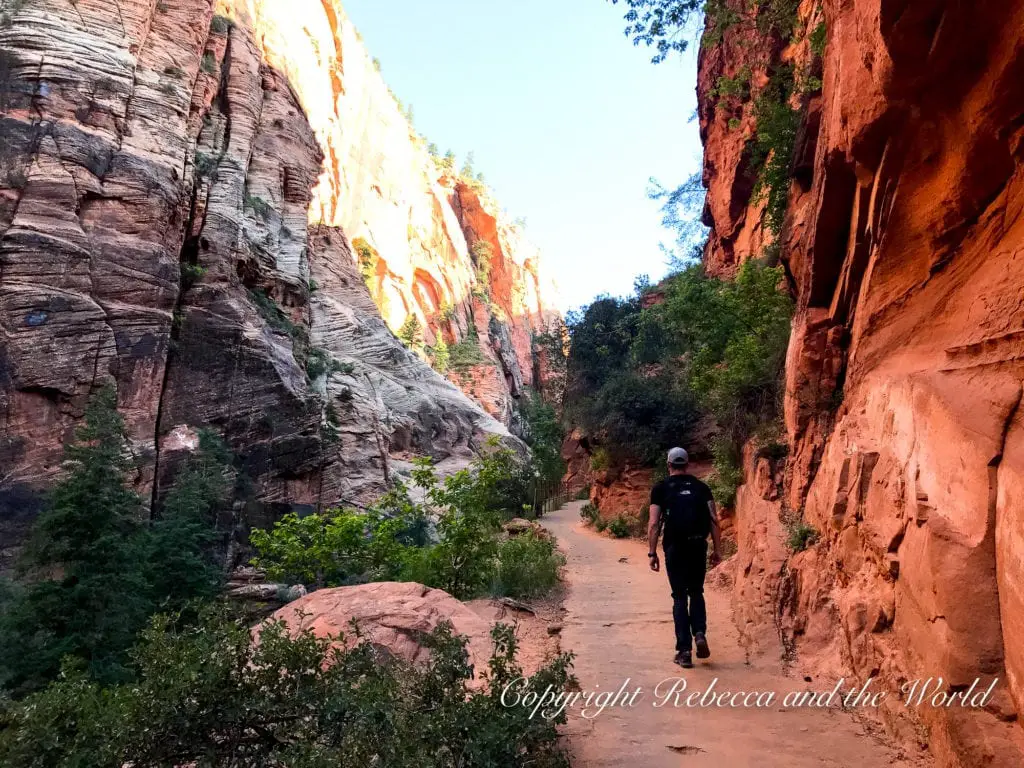
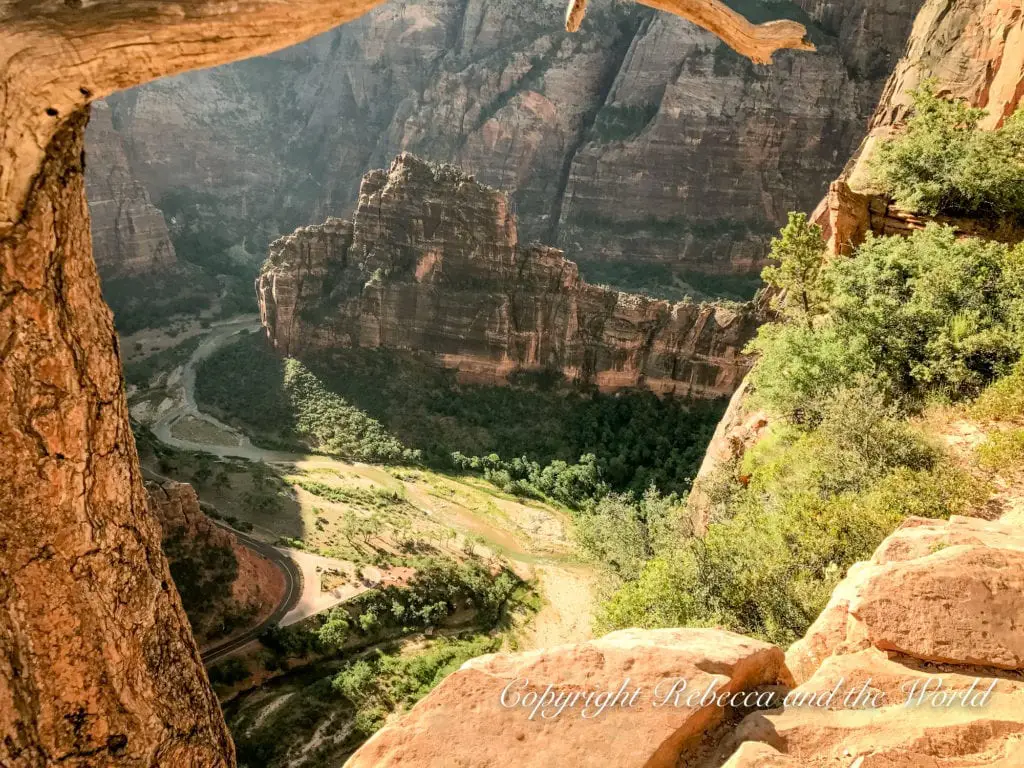
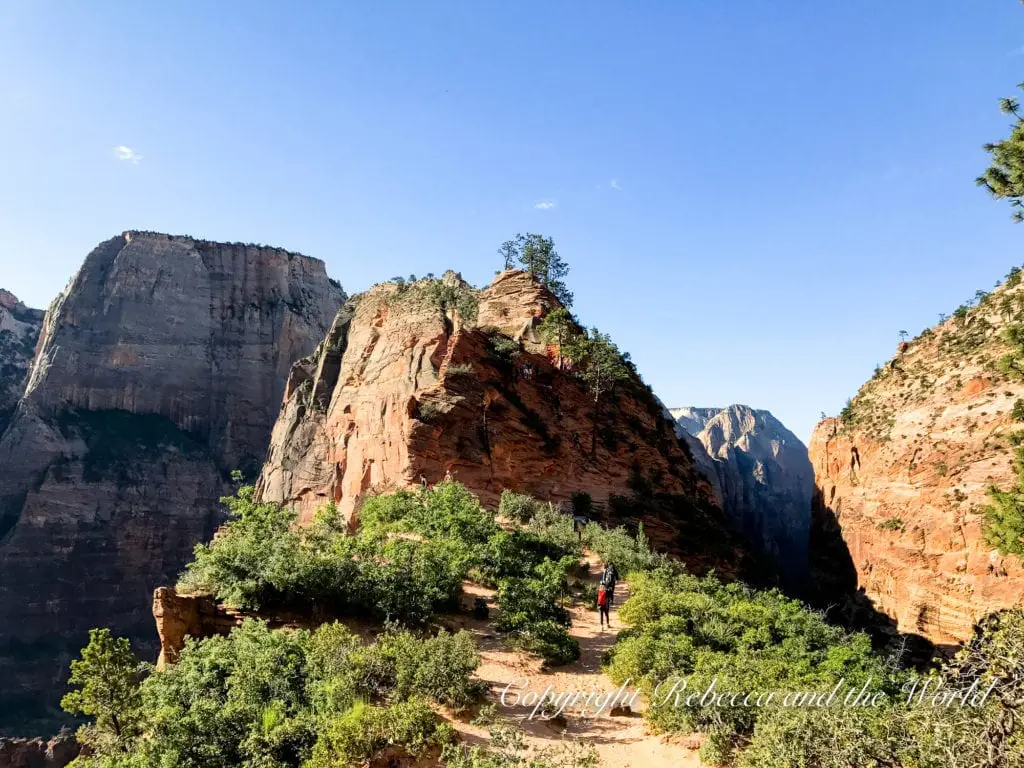
Later in the afternoon, take off on your next hike along the Riverside Walk.
If you can brave the icy water, end the day by wading through the start of The Narrows hike. We only did a small portion of this, and I would love to come back and do it completely. You can hike as far as Big Spring without a permit. It’s a 10-mile round-trip, so you’ll need the whole day to tackle this.
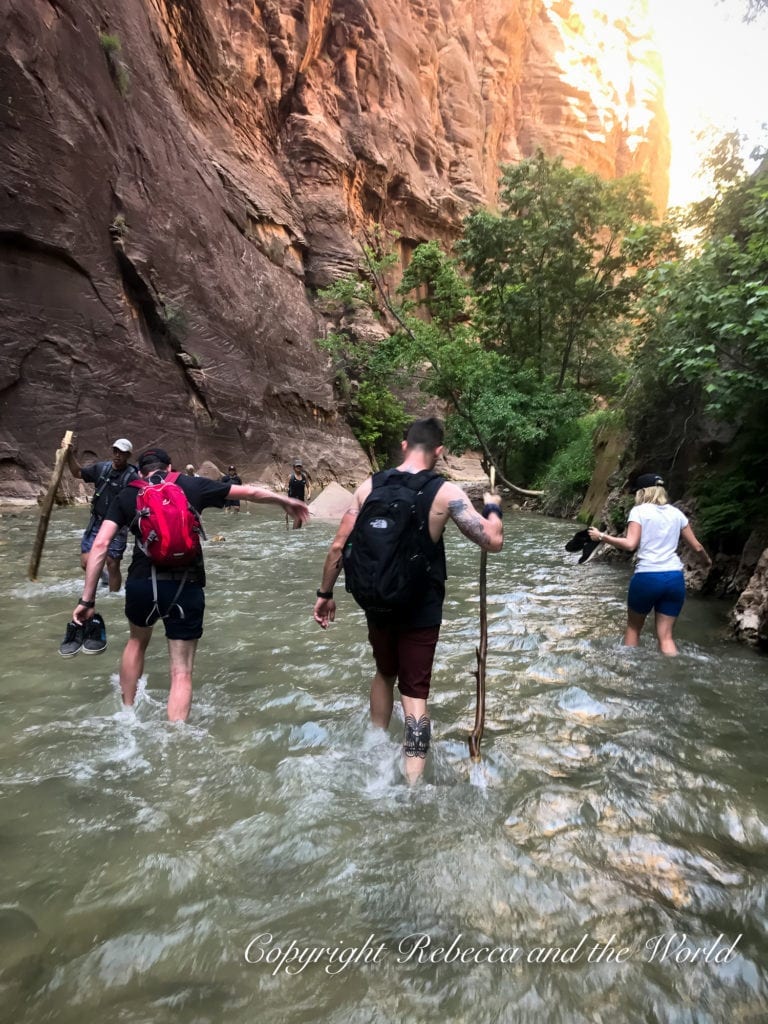
Best hikes in Zion National Park
- Angel’s Landing (5.4 miles, strenuous)
- Observation Point (8 miles, strenuous)
- Canyon Overlook Trail (1 mile, moderate; easier alternative to Angel’s Landing)
- Riverside Walk (2.2 miles, easy)
- Weeping Rock Trail (0.4 miles, easy)
- The Narrows (10 miles (to Big Spring) return trip, strenuous; high water levels and the risk of flash flooding can mean this is closed at some times during the year)
Day 3: Bryce Canyon National Park
Driving time: 1.5 hours / 75 miles
Leaving Zion National Park on your way to Bryce Canyon, traverse the scenic 12-mile Zion-Mt Carmel Highway, passing through the historic tunnel. It’s a beautiful, winding road that exposes the red rocks of Zion.
It’s time to see just how different Bryce Canyon National Park, with its orange and white hoodoos, is to the deep red rocks of Zion National Park.
In my opinion, Bryce Canyon is the best national park in Utah. The landscape is out of this world and when we visited it was far quieter than Zion.
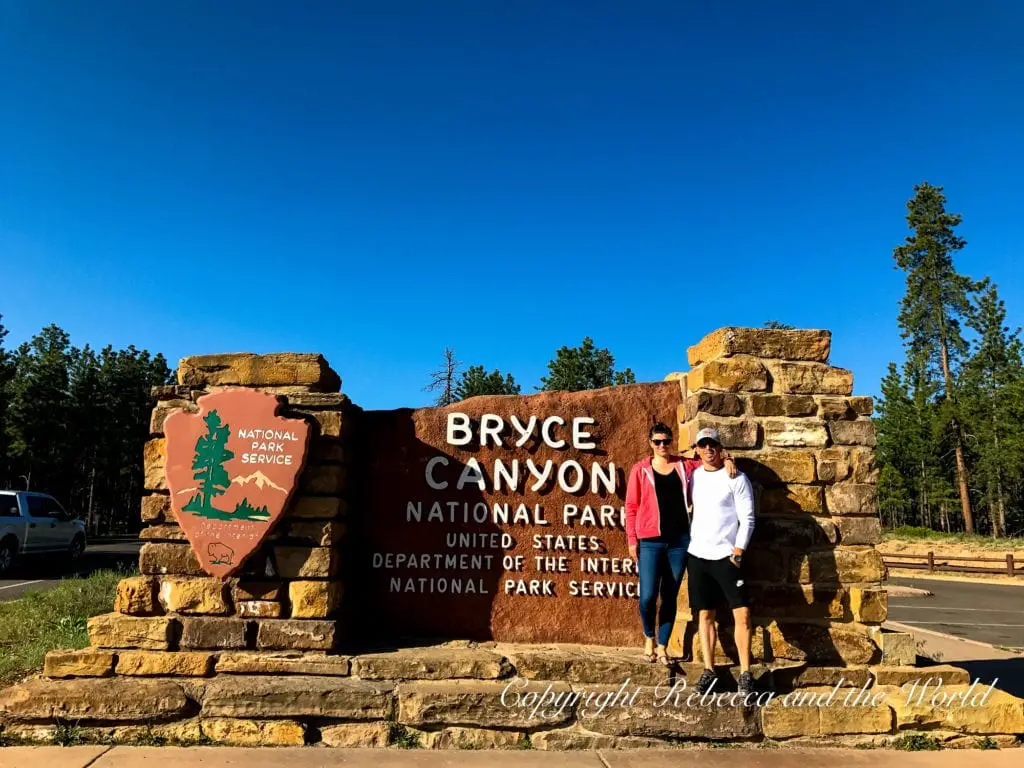
Hike the Navajo Loop / Queen’s Garden trails which take you down into and back up the canyon and past Thor’s Hammer. Later, hike a section of the Rim Trail, and stand above the hoodoos to get an idea of what Mars surely must look like.
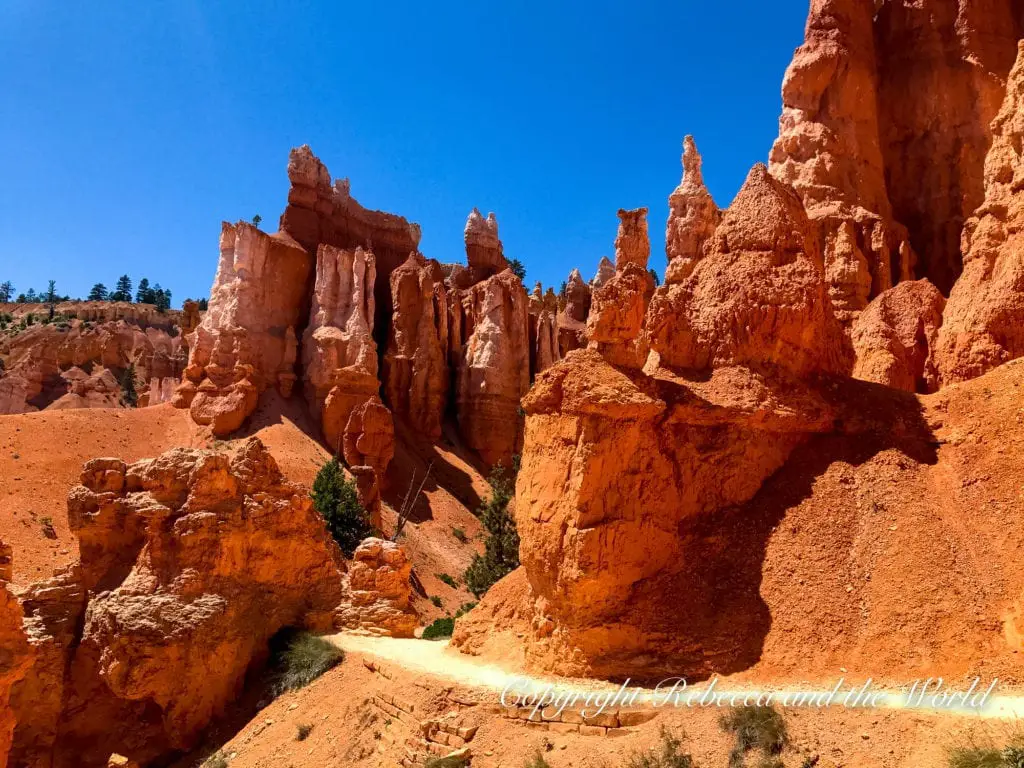
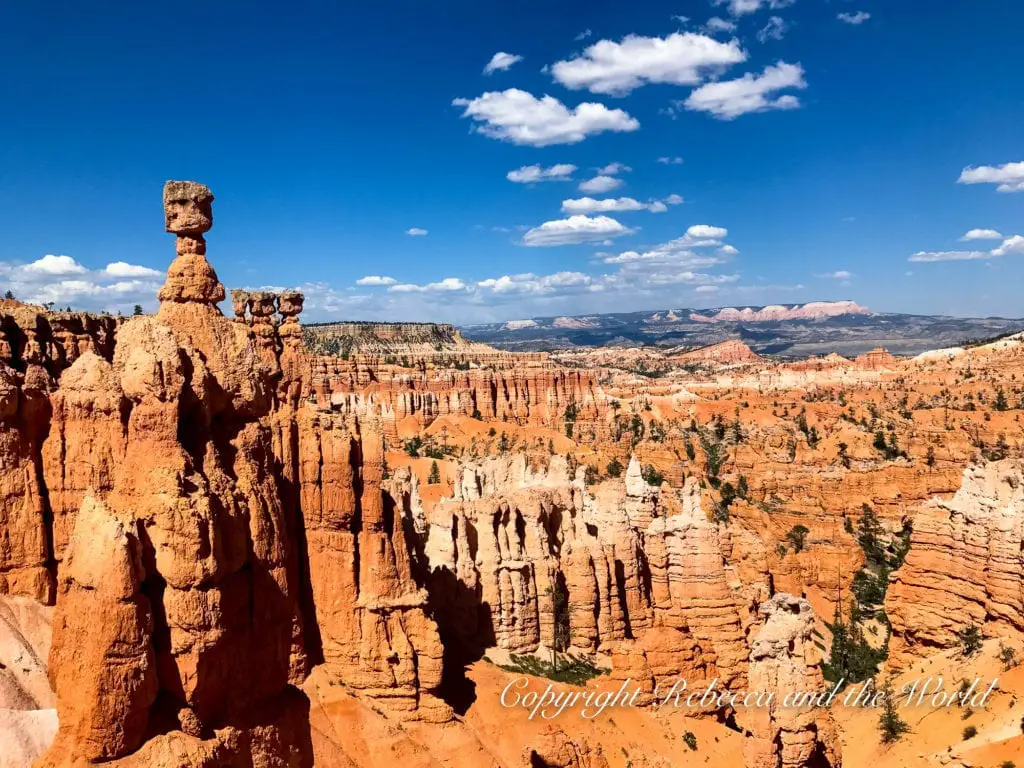
Sunset at Inspiration Point is a must, watching the colours of the hoodoos change as the sun goes down.
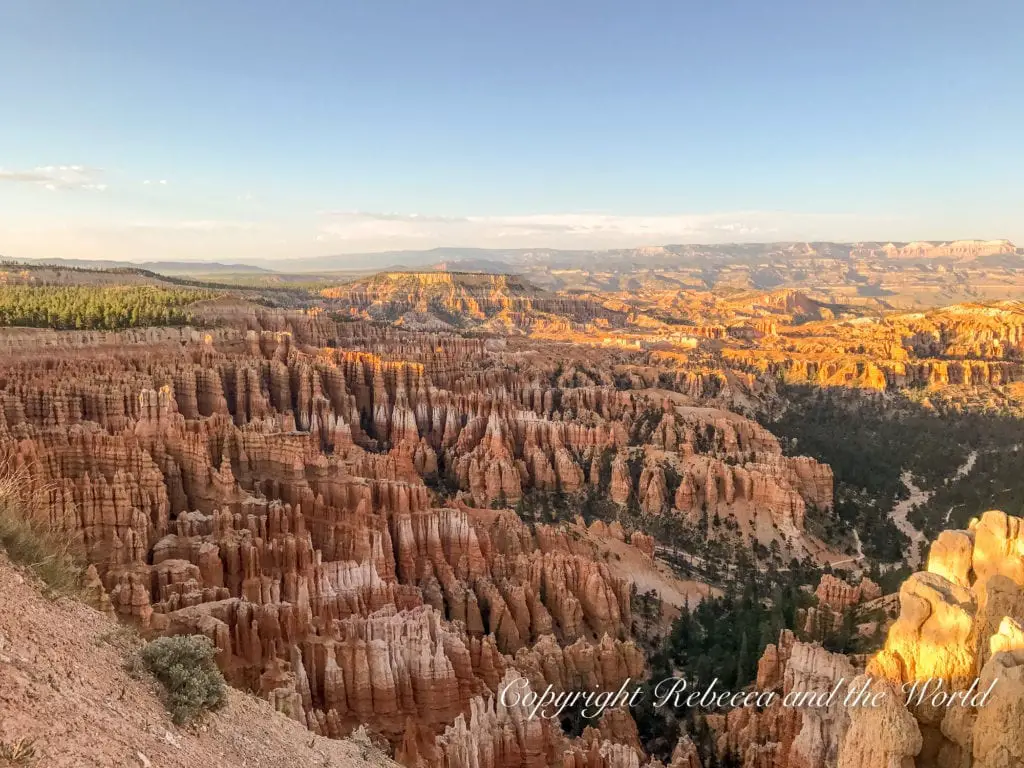
Best hikes in Bryce Canyon National Park
- Navajo Loop / Queen’s Garden (2.9 miles combined, moderate)
- Rim Trail (up to 11 miles, easy; paved from Sunset to Sunrise Points)
- Fairyland Loop (8 miles, strenuous)
Bryce Canyon National Park quick reference guide
Entrances: The only entrance to the park is via UT 12; you’ll pass through the small town of Bryce
Entrance fee: Private Vehicle, $35, valid for 7 days
Website: Bryce Canyon National Park
Tips: Visitors are encouraged to take advantage of the free shuttle bus that operates through the park
Where to stay in Bryce Canyon National Park
Bryce Canyon National Park campgrounds
There are two campgrounds in Bryce Canyon: North Campground and Sunset Campground (sites $30 per night). Both are close to the visitor centre.
Campsites at both campground can be reserved between mid-May and early October. For the rest of the year, they operate on a first-come, first-served system.
Outside of Bryce Canyon, Ruby’s Inn has an RV park and campground, which is where we stayed.
Hotels near Bryce Canyon National Park
If you’re not camping, try one of the hotels near Bryce Canyon National Park.
- Ruby’s Inn Best Western Plus is a popular option outside Bryce Canyon National Park (we stayed at the adjoined RV park and campground)
- The Lodge at Bryce Canyon is located inside the park, with 114 rooms and an on-site restaurant
- Stone Canyon Inn has several cabins onsite
Vacation rentals near Bryce Canyon National Park
- This charming country home on a large property – with fruit picking available in the fall
- This incredible chalet halfway between Zion and Bryce Canyon National Parks
Day 4: Monument Valley
Driving time: 4.5 hours / 275 miles
On day four of the Utah national parks road trip, we’re actually heading into another state: Arizona!
As I mentioned earlier, you can skip Monument Valley if you want to stay in Utah and spend more time at the Mighty 5 national parks. But it’s a great detour.
It’s a long day of driving from Bryce Canyon south into Arizona. Stop for pie at the retro Thunderbird Restaurant at Mt Carmel Junction. As an Australian, this place is exactly how I always pictured American diners to be!
Stop at Page, home to the highly Instagrammed Horseshoe Bend, and nervously watch everyone as they perch on the edge to get the perfect selfie.
It’s a hot and dusty walk to the viewpoint, so bring adequate shoes and lots of water and sunscreen. To manage the huge influx of visitors that Horseshoe Bend has recently experienced, you’ll now need to pay an entrance fee of $30 per passenger vehicle.
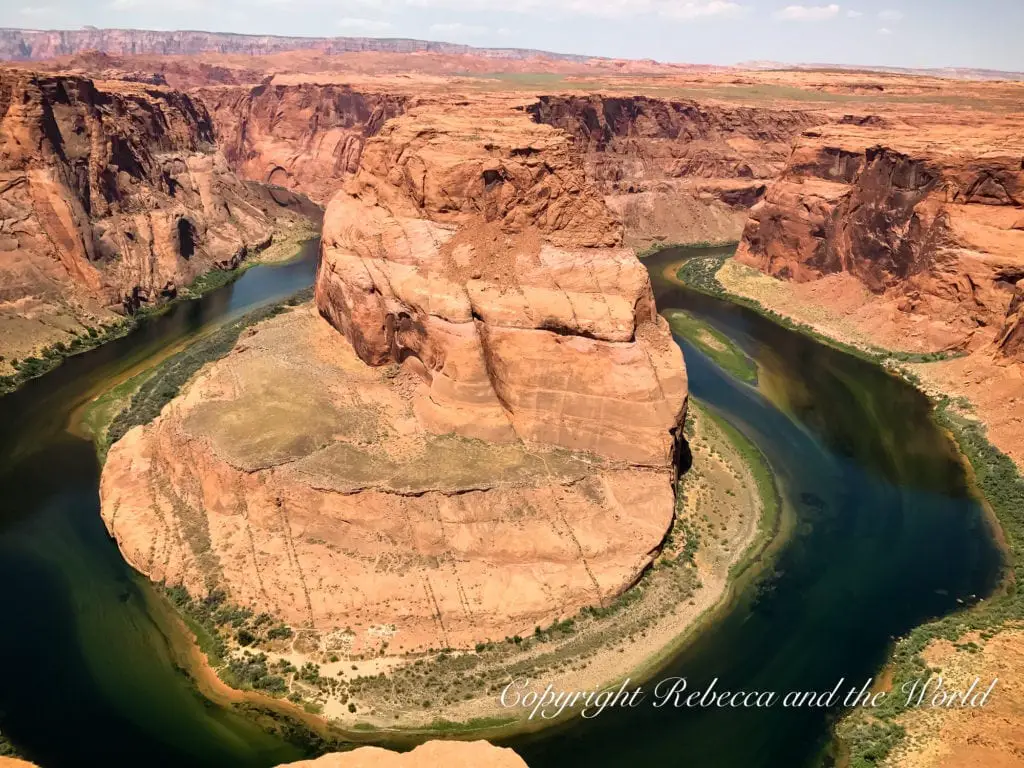
Another popular site in Page is Antelope Canyon. Here you can visit Upper Antelope Canyon, an incredible slot canyon. Reservations are a must. We unfortunately didn’t have time, but photos I have seen are spectacular. If you can make the time, there are tours of Lower Antelope Canyon and Upper Canyon.
If you have even more time, many people add on a trip to the Grand Canyon to their Utah national parks road trip itinerary. You’ll need at least two days, though, to see the park properly.
Continue on to Monument Valley, famous from oh-so-many movies. Drive through the valley ($8 per person, per day; Monument Valley isn’t covered under the America the Beautiful national parks annual pass) in the late afternoon as the sun is going down for some spectacular silhouettes of the buttes. Early morning is another option for nice light.
You need two to three hours to do the 17-mile self-guided driving tour through Monument Valley (maps available at the Information Center).
There are a few hiking trails (permit required) or you can take an organised tour which will allow you access to a traditional Navajo hogan, a small house. Here’s a good option for a sunset tour, or a 2.5-hour trip with backcountry access where you’ll learn more about Navajo culture.
Be respectful of the land at all times and stick to the trails – this is Navajo land.
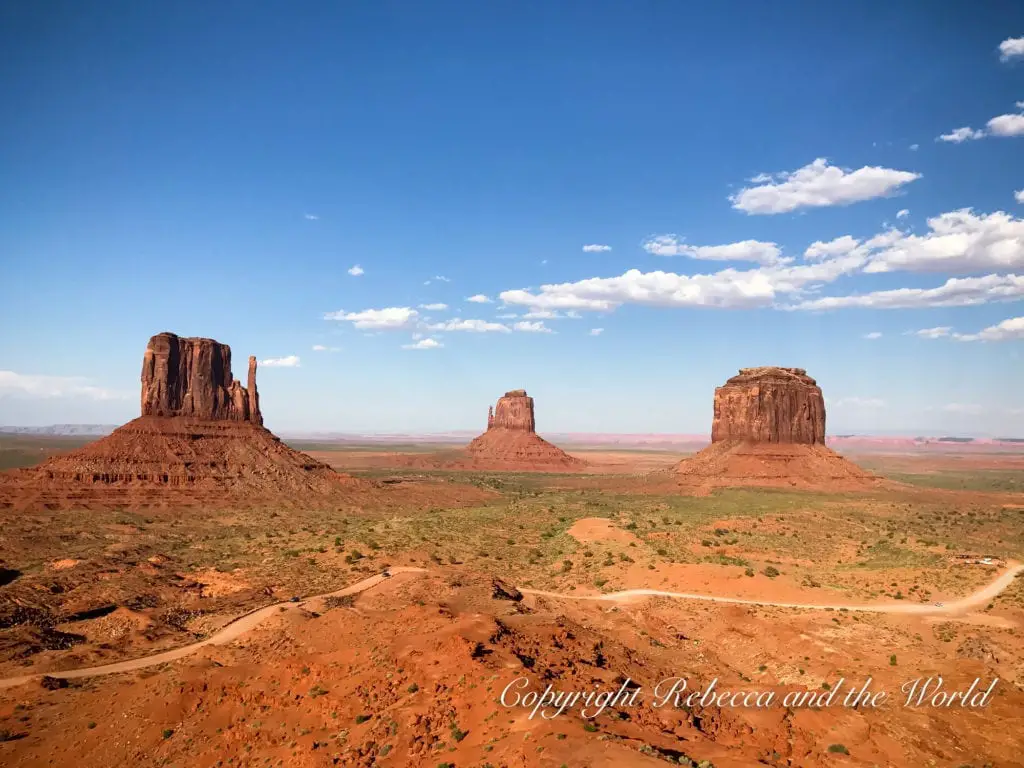
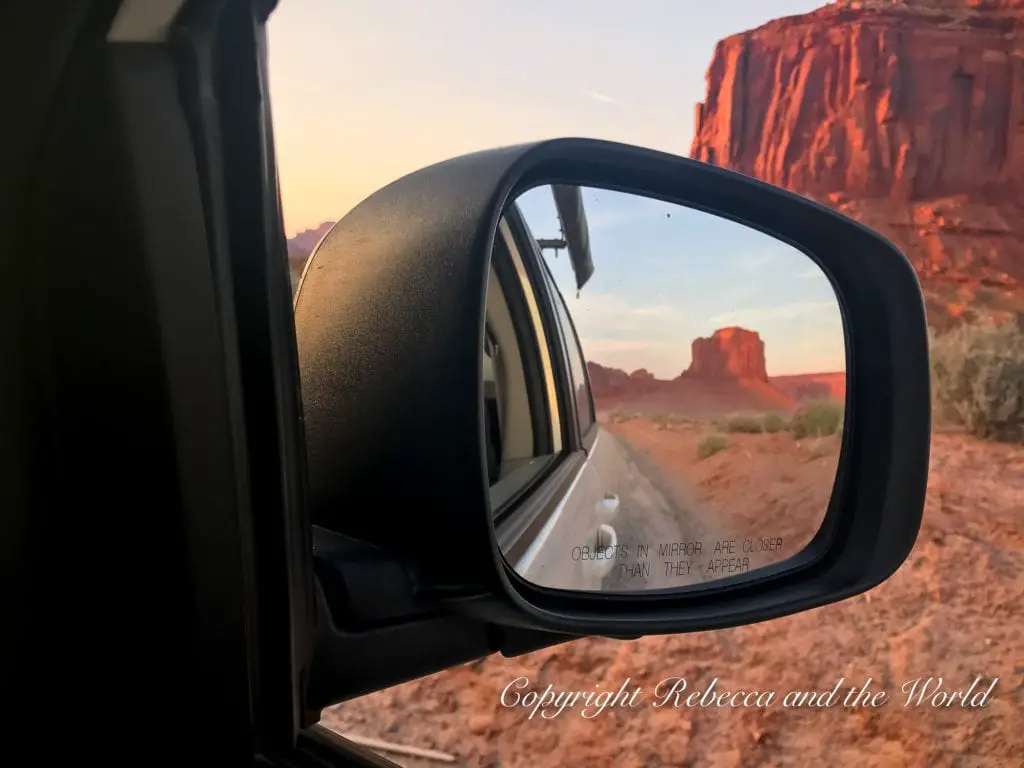
Hotels near Monument Valley
There are a couple of hotels near Monument Valley:
- We parked our campervan at Goulding’s Lodge, which has both a hotel and campground. It’s also got a restaurant, gas station, laundry, trading post and a museum highlighting the history of the area, including about the films that have been shot there. The theatre shows John Wayne movies nightly
- The View Hotel is located within Monument Valley Navajo Tribal Park. As the name suggests, it has great views over the valley
Day 5: The Needles, Canyonlands National Park
Driving time: 5.5 hours / 238 miles
Day five will see you heading back into Utah on your way to Moab. Before you get too far, stop at mile marker 13 on highway 163 for the classic road jumping shot with Monument Valley in the background.
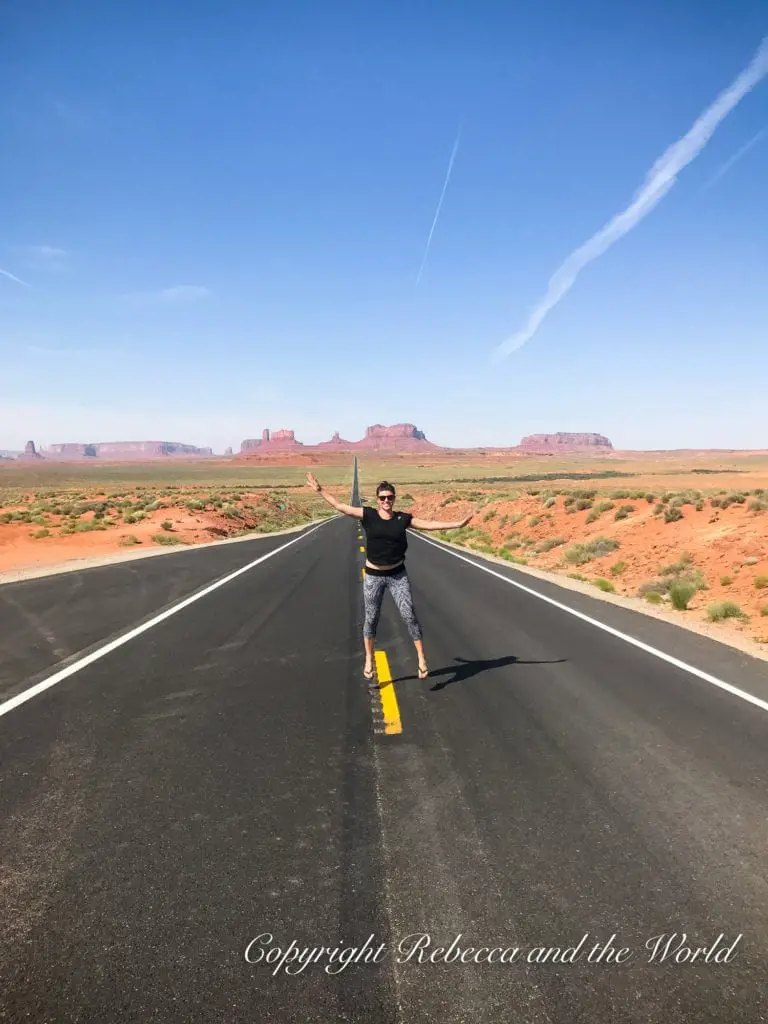
Before getting to Moab, take the long detour to The Needles area of Canyonlands National Park. It’s a side trip off the main road and does add extra time to this Utah road trip itinerary, but it’s worth it. If you’re short on time, then you can skip this and head straight to Moab.
Canyonlands National Park is actually split into three distinct areas by the rivers that run through the park: The Needles, Island in the Sky and the Maze. The Maze is only accessible by 4WD and is very remote. I haven’t included it in this Utah national parks itinerary because we didn’t visit it.
The Needles is far less touristy than the other national parks in Utah. To get a taste of the park, hike the Slickrock trail, which will take you over smooth, mustard-coloured rocks as you follow the cairns-marked trail.
After that, hit up another hike like the Cave Spring trail. This one winds through old cowboy hangouts and up ladders. Again, you’ll be marvelling at just how different the landscape is compared to the other national parks visited on this trip.
We only wish we’d had more time to do some of the longer, more challenging hikes. Unfortunately, there was a spectacular lightning storm starting up as we began hiking, and we didn’t want to be exposed.
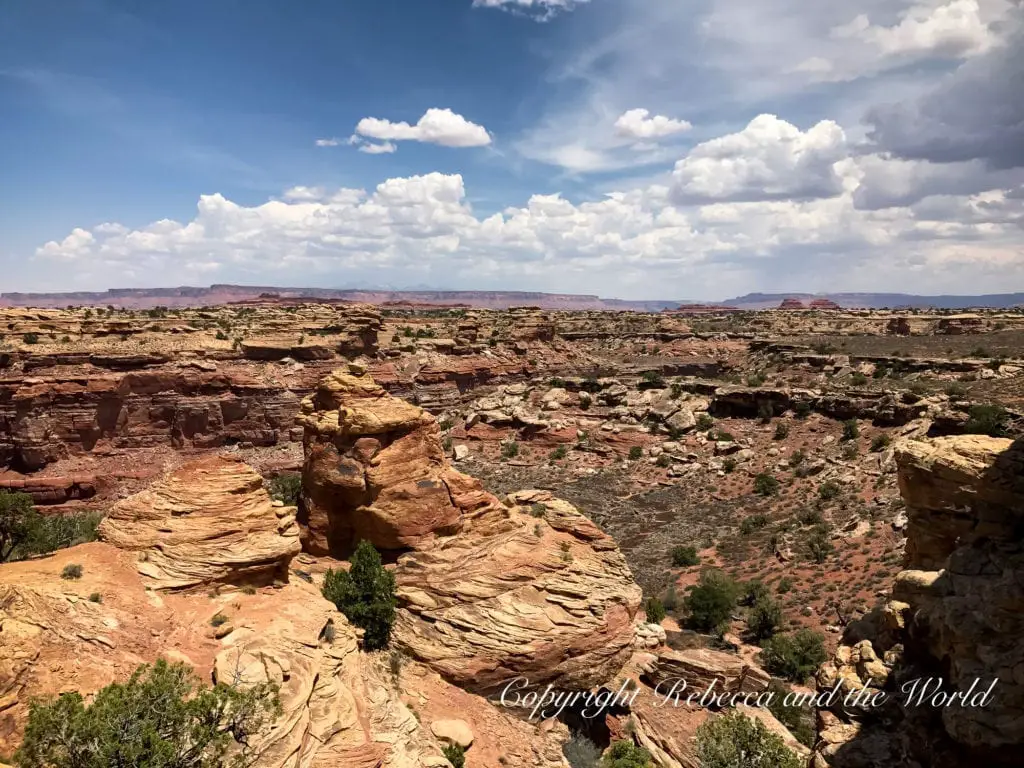
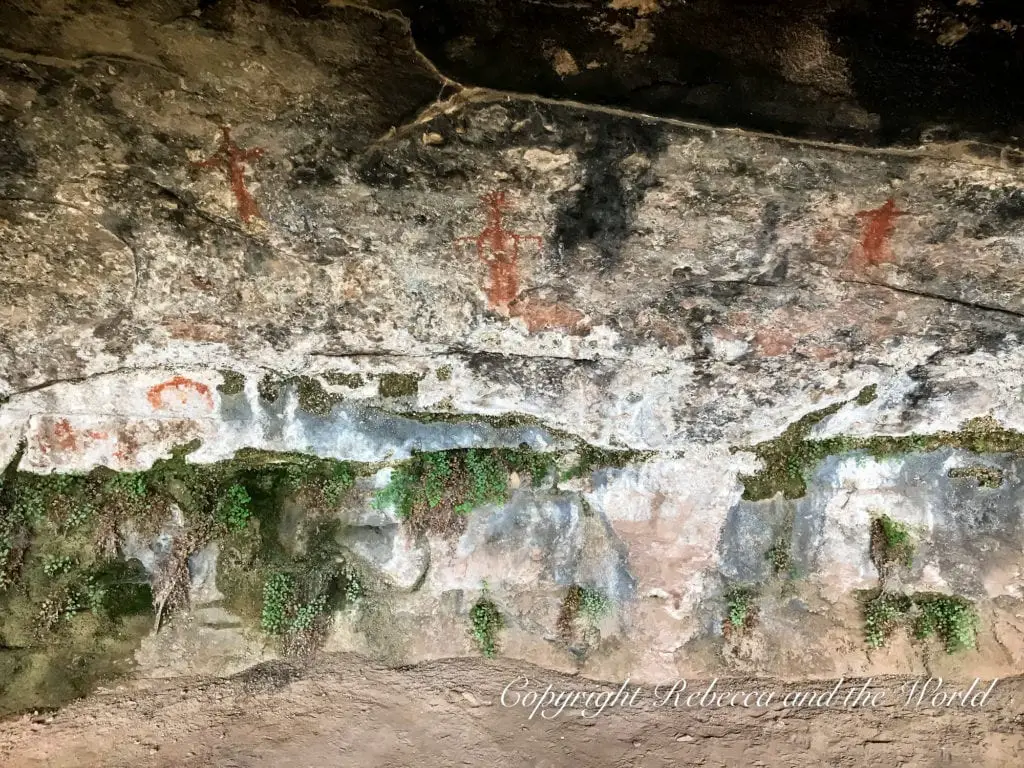
Continue on to Moab and have a late lunch of burgers and peanut butter milkshakes at Milt’s Stop and Eat.
Best hikes in The Needles, Canyonlands National Park
- Chesler Park Viewpoint (6 miles, strenuous)
- Slickrock Trail (2.4 miles, short)
- Big Spring Canyon to Squaw Canyon (7.5 miles, strenuous)
- Cave Spring (0.6 miles, short)
Canyonlands National Park quick reference guide
Entrances: The entrance to Island in the Sky is about 40 minutes from Moab, while The Needles entrance is about a 90-minute drive
Entrance fee: Private Vehicle, $30
Website: Canyonlands National Park
Tips: Moab is the best place to base yourself to see the two main sections of the park
Where to stay in Moab
Moab campgrounds
- We stayed at the KOA campground in Moab. Staff were friendly and they have a pool and shop onsite.
Hotels in Moab
Moab is a small town, but its reputation as an action hub means that it’s full of hotels and campgrounds.
- The Gonzo Inn is a popular place to stay in Moab. There’s an outdoor pool which will be a huge relief in the heat of the afternoon – Moab gets really hot
- Red Cliffs Lodge has 115 simple rooms, some with balconies with great views over the river
Vacation rentals in Moab
There are plenty of vacation rentals in Moab, so you’ll have lots of choices. I like the look of:
- This light-filled cabin with a great patio with grill (and it’s dog friendly!)
- This property would be good for groups of up to 6 people
Day 6: Arches National Park and Island in the Sky
Arches National Park is just outside of Moab, and is famous for its variety of sandstone arches.
Tackle some of the shorter hikes to Broken Arch and Sand Dune Arch in the morning.
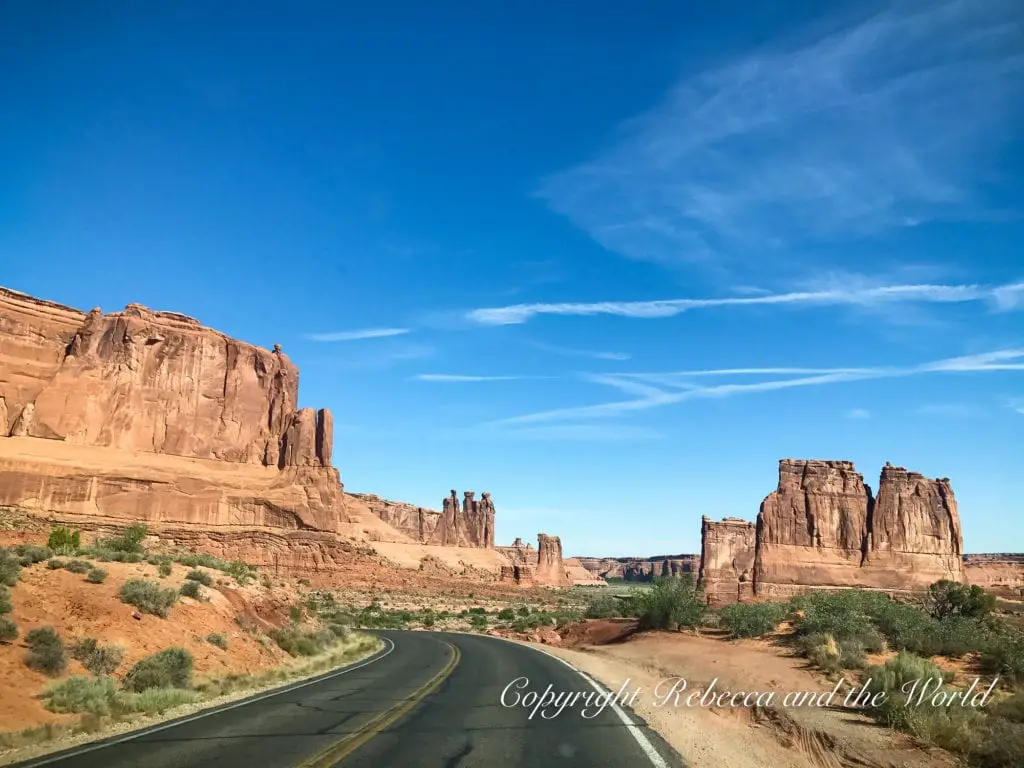
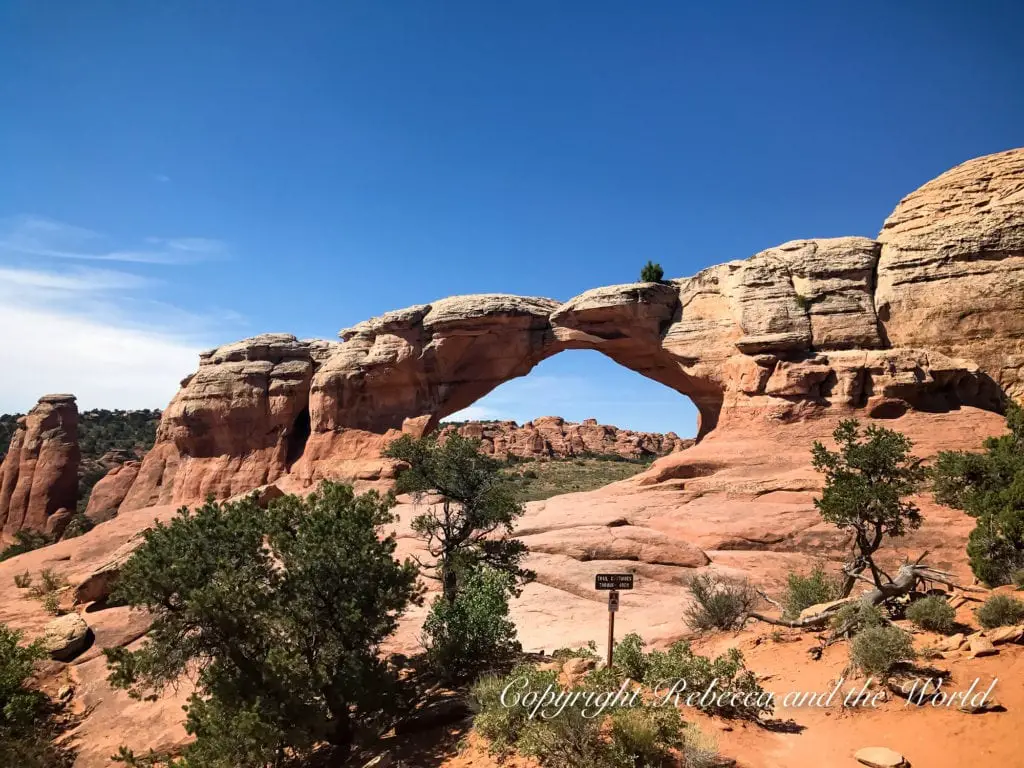
In the afternoon, hike to Delicate Arch. This is a must-do on your visit to Arches National Park. Be aware that this hike has no shade, and the last part is around a cliff face with a sharp drop off. It’s one of the most photographed spots on any trip to Utah.
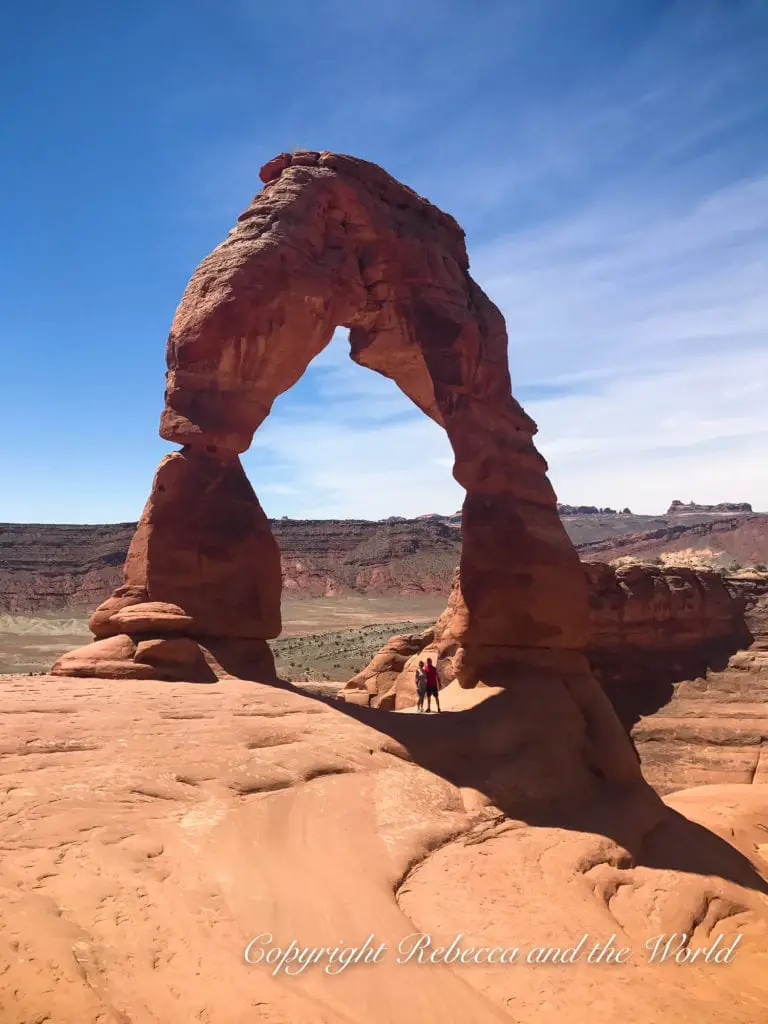
Best hikes in Arches National Park
- Delicate Arch (3 miles, strenuous)
- Double O Arch Trail (4.2 miles, strenuous)
- Park Avenue Trail (1 mile one-way, moderate)
- Devil’s Garden (7.2 miles, strenuous)
- Windows Trail (1 mile, easy)
- Fiery Furnace (reservation necessary, guided by Park Ranger)
Arches National Park quick reference guide
Entrances: The entrance is just a 10-minute drive from Moab
Entrance fee: Private Vehicle, $30, valid for 7 days
Reservation needed: Between 1 April and 31 October, you’ll also need to book a timed entrance. Book online here
Website: Arches National Park
Before sunset, drive out to the other section of Canyonlands National Park, the Island in the Sky. From the viewpoint, gaze out over the land, which looks like a giant dinosaur has left its footprint behind.
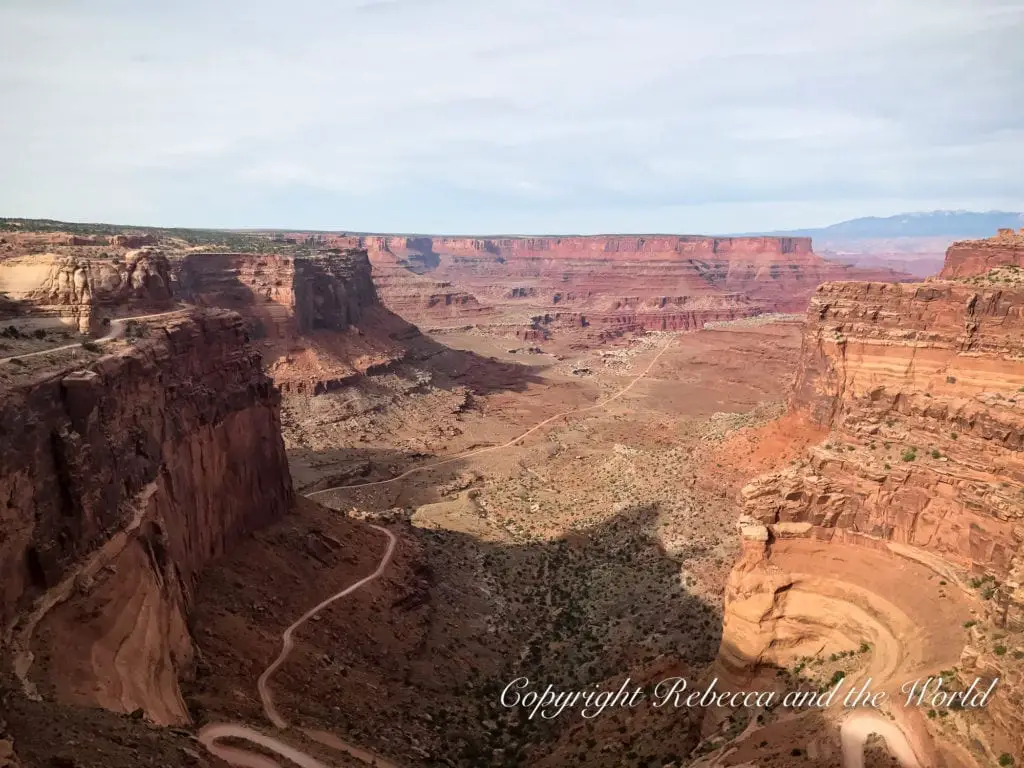
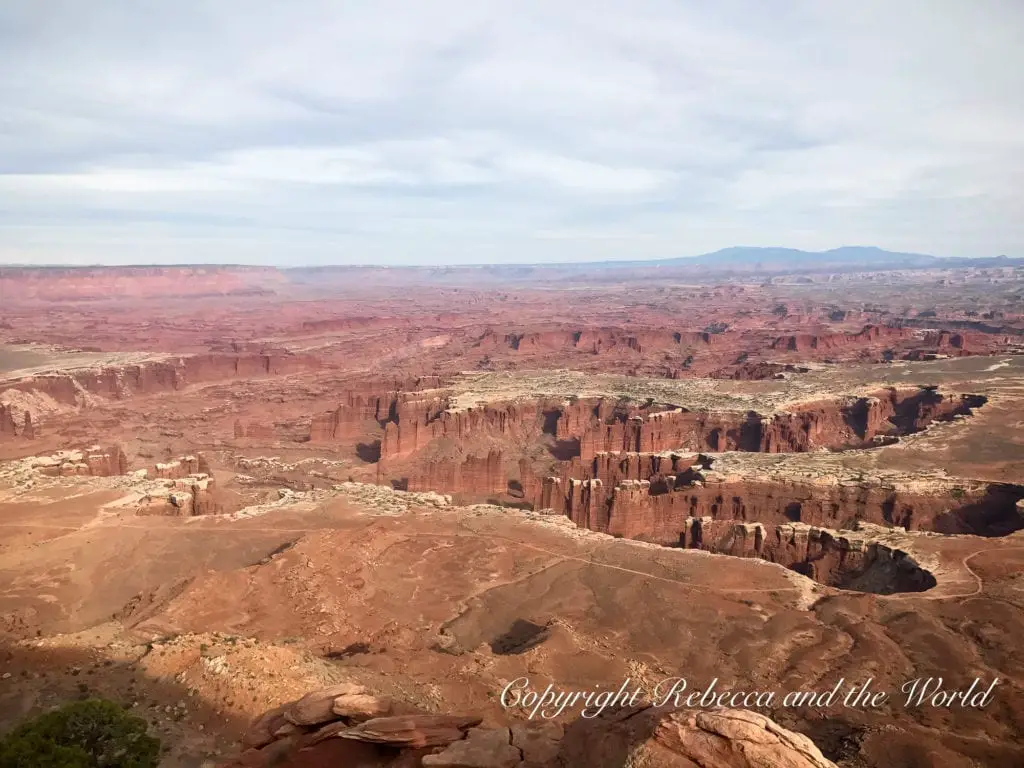
If you’re in luck, you might even have Mesa Arch all to yourselves for a few minutes. Most people recommend to visit Mesa Arch at dawn, but we found it to be just as beautiful at sunset.
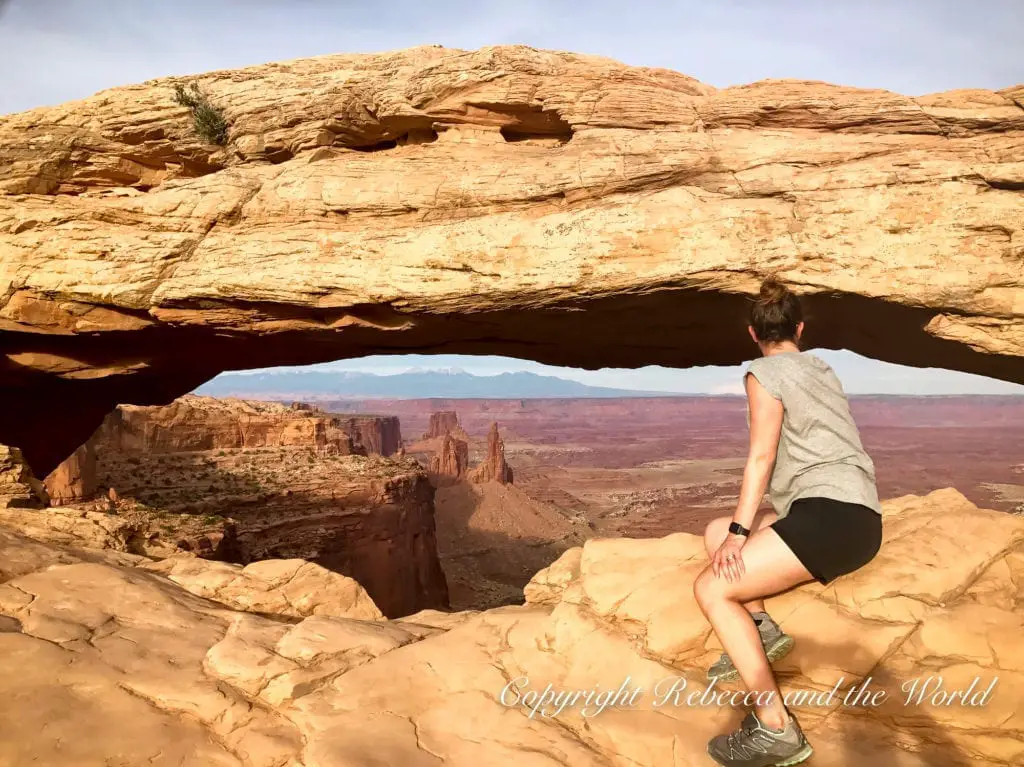
Moab is one of the best places to visit in Utah for adventure lovers, so if you’ve had enough of hiking, you can try mountain bike riding, offroading, 4×4 adventuring, rappeling or rafting on the Colorado River. There are companies throughout Moab that offer all sorts of outdoor adventures.
Best hikes in Island in the Sky, Canyonlands National Park
- Mesa Arch (0.5 miles, easy)
- Grand View Point Trail (2 miles, easy)
- Neck Spring (5.8 miles, moderate)
- Gooseberry Trail (5.4 miles, strenuous)
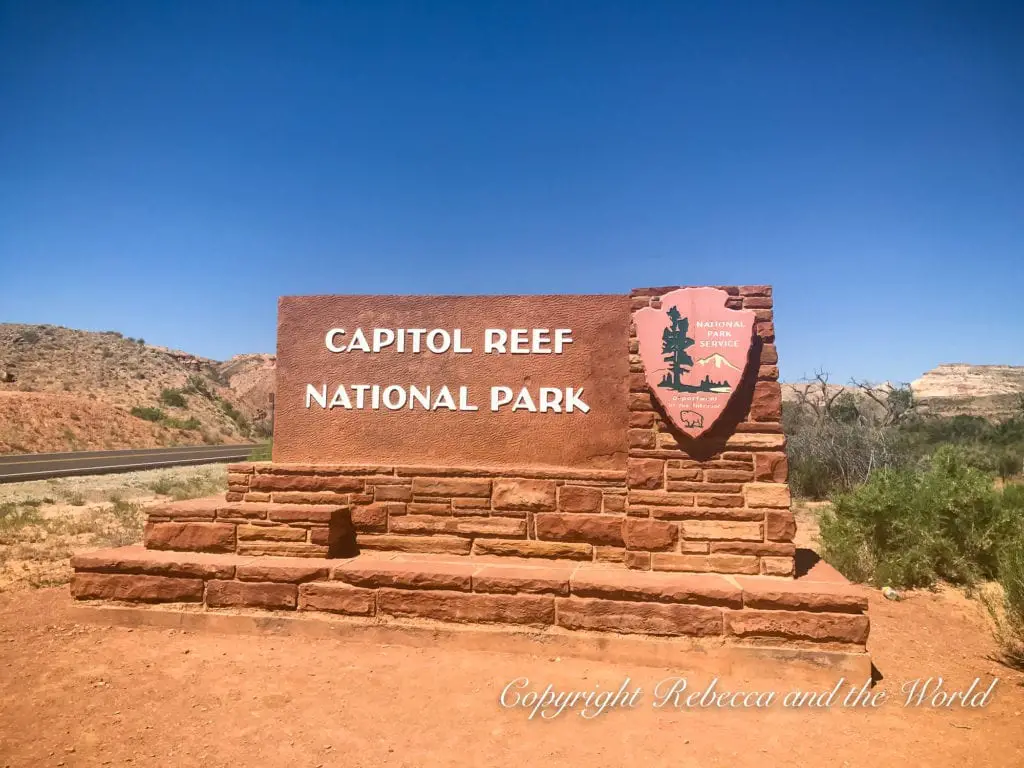
Day 7: Capitol Reef National Park and back to Salt Lake City
Driving time: 5.5 hours / 369 miles
On the last day of the road trip, return to Salt Lake City via Capitol Reef National Park.
As the smallest of the five Utah national parks, you can easily drive through it via the 9-mile scenic drive and stop off to do shorter hikes. We only spent a few hours here, the shortest visit of our trip.
The park also has an old Mormon mission and you can stop by the historic Gifford Homestead to enjoy a fruit pie in the shaded grounds. The perfect sweet way to finish your Utah national park itinerary!
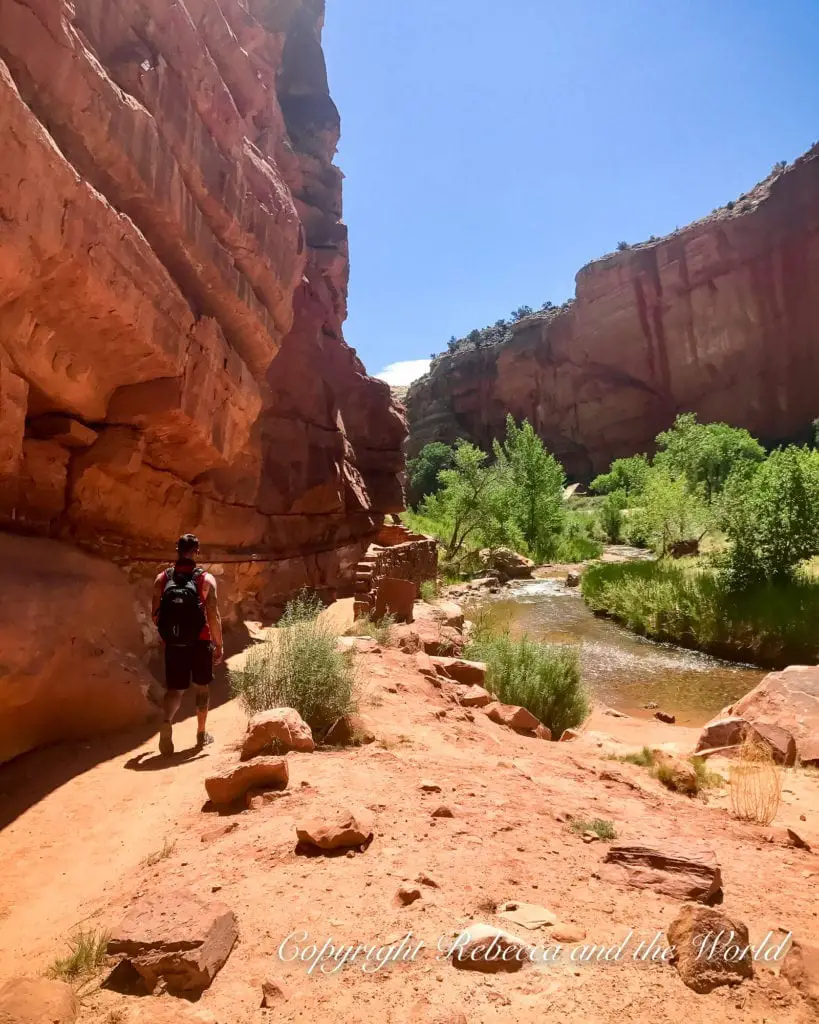
Best hikes in Capitol Reef National Park
- Sunset Point Trail (0.4 miles one-way, easy)
- Hickman Bridge Trail (0.9 miles one-way, moderate)
- Chimney Rock Trail (3.6 miles, strenuous)
- Rim Overlook Trail (2.3 miles, strenuous)
Capitol Reef National Park quick reference guide
Entrance fee: Private Vehicle, $20, valid for 7 days
Website: Capitol Reef National Park
Where to stay near Capitol Reef National Park
If you do decide to stay longer than a few hours or one day, here are a few options for sleeping.
Capitol Reef National Park campgrounds
There’s only one developed campground within Capitol Reef, and that’s the 71-site Fruita Campground. The fee is $25 per night, and sites are reservable only between 1 March and 31 October. The rest of the year it’s first come, first served.
Hotels near Capitol Reef National Park
- For something truly unique, book a night in a Conestoga wagon! Peek out your wagon at Capitol Reef Resort in the morning for stunning red rock views. Or, choose from luxury teepees and cabins
- Broken Spur Inn and Steakhouse (located in Torrey) is a simple hotel only a 10-minute drive to the entrance of Capitol Reef National Park
Vacation rentals near Capitol Reef National Park
- This cute cabin is great for couples or small families
- This 2-bedroom home with a great deck in the nearby town of Teasdale
Finally, return your car or campervan in Salt Lake City – 7 days in Utah goes by quickly! This will be a trip you won’t quickly forget – and if you’re like me, you’ll be wanting to go back very soon.
Tips for planning a Utah national parks road trip itinerary
Buy a national parks pass
If you’re planning to road trip to Utah national parks, buy the America the Beautiful annual pass, which costs $80. Each national park costs between $20 and $35 to visit, so if you visit three or more parks on this Utah mighty 5 road trip, this pass will save you money.
The pass is also valid at any national park in the entire United States so you can use it at other parks for the rest of the year.
Book accommodation in advance
Hotels, lodges and camping sites around the national parks can be booked out months – even a year – in advance, so book accommodation in advance. (I use Booking.com and Expedia to book accommodation, comparing prices across both sites before I book.)
Each campsite has different processes for booking. Some can be booked online in advance, others can only be booked in person on the day, so you’ll need to factor this in to your planning.
Research each park before you visit
Do your research on each park’s website in advance – there’s a huge amount of information available online. This will help you plan your days to get the most out of each park.
And when you arrive at each park, stop by the visitor centre to pick up a map and talk to the rangers. They know the best time to visit each location for the perfect photos and which hikes to do to maximise the time you have.
Best time to visit Utah national parks
We visited in early June and found it to be a great time to visit the Utah Mighty 5 – just before school vacation so the crowds were not quite in full force, and the weather was warm and sunny, but not yet suffocatingly hot.
Spring and autumn/fall
These are the best seasons to visit the national parks in Utah – but also the most popular. Temperatures are milder, so hikes will be more manageable, but you’ll have to battle the crowds.
Summer
It goes without saying that summer is the hottest time to visit the national parks of Utah, with temperatures often creeping toward 100 degrees Fahrenheit (40 degrees Celsius). If you must visit during these months, plan your visit carefully and aim to hike either early in the morning or late in the afternoon. And always have plenty of water with you.
Winter
The winter months can bring temperatures below freezing at night – and snow. I’ve seen photos of some of the national parks during winter and it looks stunning with snow-dusted peaks and few crowds, but make sure to come with adequate winter clothing.
What to pack for a Utah national parks road trip
When you’re visiting the national parks in Utah, come prepared. Here are a few items I’d recommend packing, and I have a longer road trip packing list guide with more ideas:
- An America the Beautiful annual pass to save you tonnes of money!
- A cell phone mount is helpful for hands-free navigating. Remember to download maps as you’ll encounter areas without service.
- Bring a good backpack for all your gear, and a daypack for hiking.
- Use a water bladder to stay hydrated while tackling the hiking trails.
- Pack sturdy hiking boots.
- Don’t forget plenty of sunscreen! It gets hot out here, and the sun can be brutal, even in winter.
- If you’re travelling in a campervan like we did or camping in Utah national parks, you may go several days without a shower (pee-yew!). Pack some body wipes to stay fresh.
- If you’re camping or in an RV, pack a power inverter to keep your electronics charged while you’re driving.
- Don’t forget a good first aid kit.
- Pick up a copy of the Lonely Planet guide to Southwest USA or Lonely Planet’s national parks guidebook so that you can learn more about Utah.
For other items you’ll need to bring on this Utah national parks itinerary 7 days, check out this packing list for camping in the national parks.
Utah national park road trip: FAQSs
How many days do you need to see the national parks in Utah?
You need at least a week to see all of the national parks in Utah. With 7 days, you can visit each of the state’s five national parks. This will give you 1-2 days at each of the national parks.
Can you see all 5 national parks in Utah?
The great thing about the Mighty 5 is that you can see all of them in a week. Follow my itinerary and you’ll be able to visit all 5 national parks in Utah in just 7 days.
How many national parks are there in Utah?
Utah has 5 national parks: Zion National Park, Bryce Canyon National Park, Arches National Park, Canyonlands National Park and Capitol Reef National Park.
Did you find this article helpful? Consider buying me a coffee as a way to say thanks!
Have you visited Utah? Which is your favourite national park? Let me know in the comments below.
Related posts
Before you go… you might like these USA road trips:
- New Mexico Road Trip Itinerary: Discover the Land of Enchantment
- Plan a Deep South Road Trip Itinerary: What to See, Do and Eat
- Mississippi Road Trip: 7 Fascinating Places to Visit in the Magnolia State
- 17 Fun Things to do in West Texas: An Unmissable West Texas Road Trip
USA TRIP ESSENTIALS
- Book flights to and around the USA online with Skyscanner. I like this site because it shows me which dates are cheaper.
- Find a great hotel in the USA. Check prices on Booking.com and Expedia online.
- Check out the huge range of day tours throughout the USA on GetYourGuide or Viator. There’s something for everyone.
- A copy of the Lonely Planet guide to the USA will be handy.
- One thing I always purchase is travel insurance! Travel Insurance Master allows you to compare across multiple policy providers, while SafetyWing is great for long-term travellers and digital nomads.
7 DAY ITINERARY UTAH NATIONAL PARKS: PIN IT FOR LATER
Don’t forget to save this Utah national parks road trip itinerary to Pinterest and guide so that you can plan your own road trip!
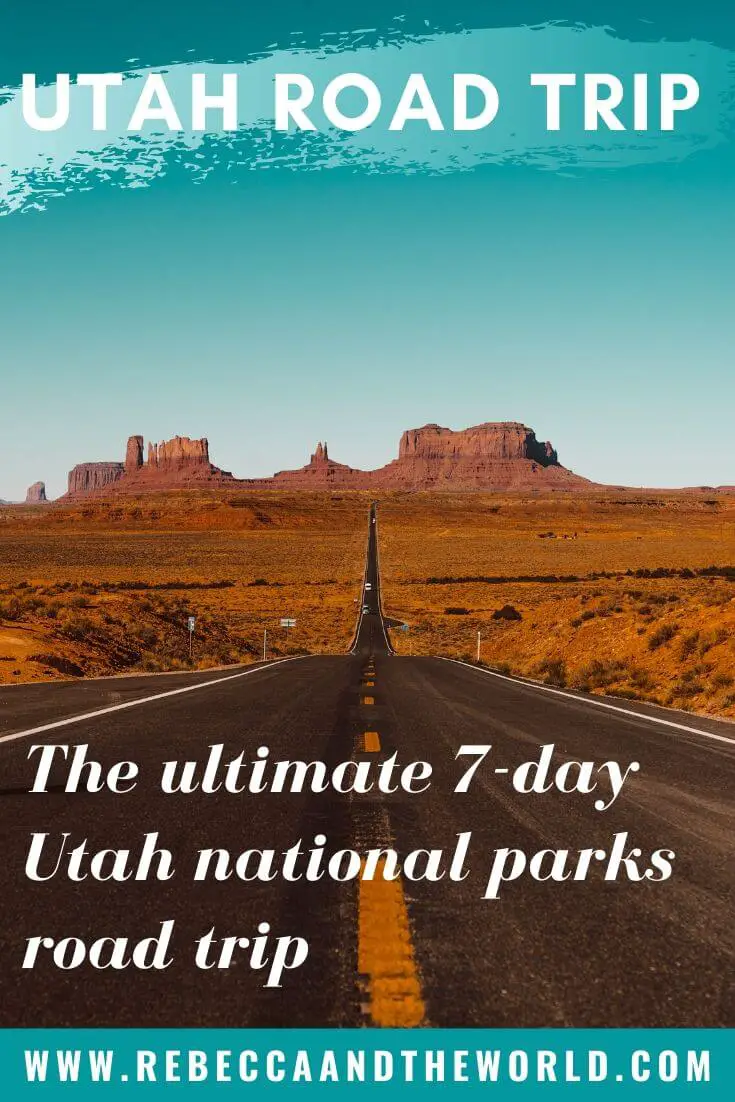





Hi Rebecca, I am looking to do a SLC to LV of the Mighty 5 plus GC, Horseshoe Bend, and Antelope Canyon in October. I have 15 days including fly days. Ideas on an itinerary? Thanks so much!
Hi Amy! You could do something like: Salt Lake City (spend a day there if you haven’t already visited), then Bryce Canyon, Capitol Reef, Moab (for both Arches and Canyonlands National Parks), The Needles portion of Canyonlands, Monument Valley, Grand Canyon, Antelope Canyon, Zion, LV. Plan to spend 2 days at least in each of Bryce, GC and Zion, plus 3 days in Moab. That should stretch you out to two weeks without feeling rushed. I’m jealous you’ll have so much time exploring this beautiful part of the world!
Hi…I love this post but I am looking to do LV to LV including a brief visit at GC, Antelope and Horseshoe and then travel on to the Utah parks. I have 10 days including flying. Any ideas on an itinerary?
Hi Joan, how fun! The most efficient route, then, would be Las Vegas – Grand Canyon – Horseshoe Bend/Antelope Canyon – Arches NP/Canyonlands – Capitol Reef – Bryce Canyon – Zion NP – Las Vegas. You could easily do that in 10 days, with one day at each stop (or two days in places you really want to spend a bit more time in). Have fun!!
Dynamite photos, loved looking at them.
Thanks! It’s such a beautiful state, so fun to drive around.
Enjoyed reading this very much. Thanks! Since you did a fair amount of driving around where I’m planning to go, wondering if you had any info/advice to share about using an RV for this trip in the winter. Curious about accessibility with the roads, whether any of the segments between parks make driving difficult because of vehicle clearance, or whether the roads are not paved and may be difficult to traverse in a larger vehicle.
Hey Patrick! So excited that you’re heading this way – it’s a beautiful part of the world. We visited in early June and had no issues with the roads – and there were so many RVs out as well. In winter, I’d say it’d be much the same. The roads between all the parks are paved and well-maintained. Even within the parks the roads are really good so I wouldn’t think you’d have any issues. The only limitation I can see is if you want to get offroad at any time. For example, driving through Monument Valley was quite bumpy in our small campervan, and it might be tough in an RV (depending on how big it is) – check first whether they even allow RVs inside the monument. Happy travelling and let me know if you have any more questions!
Just got back from Zion, but I want to see them all!
What I loved about all the parks in Utah is just how close they were to each other – so it is possible to see several in just a few days!
Such incredible photos – Zion National Park looks like a different planet!! What an adventure – definintely one for the bucketlist!
Absolutely! Was such a great trip 🙂
Rebecca!! Seriously, I cannot thank you enough for opening my eyes to the world of camper vans! We leave in two weeks and last minute Chase wanted to camp (and we pretty much have no camp supplies, although it’s been on my list to get for this summer – to start small and camp close to home LOL, he was ready for a 3000 mile away camp trip), so it left us scrambling to figure out how to get a tent on a plane, oh and then buying a tent, and yadda! We already reserved a rental car, but believe we are returning it and going with the camper van. This post made me even more excited!
Thank you again! <3
Oh I’m so glad I saw your post and commented. It really does make life easier – you don’t have to lug a whole lot of stuff on to a plane, and buy stuff that you might not use again. It will be a bit cold while you’re there, too, so sleeping inside a van will make it a little warmer. Have so much fun – can’t wait to see your pics!!
This post reminds me of your adventure to see Mt Fitz Roy in Patagonia for you took some really great shots at both places! Weather plays an important role in making an outdoor adventure pleasant or not, and you seem to always know when to go. I have to say your photos of those national parks in Utah are some of the best I’ve ever stumbled upon! Btw, in that photo of you and other hikers wading through the icy water at the start of The Narrows, it’s not easy to spot which one your husband is. That bird of paradise reminds me of the days when you were still living in PNG. 🙂
Bama, you always leave the nicest comments!! This really brightened up my day when I first read it and I was in a slump about blogging in general. Thank you! And the fact that you noticed the bird of paradise tattoo! 🙂
Wow Rebecca this is a wonderful blog. I have really enjoyed reading it and will read the others. Elly just told me about it. Glad she did as it gives me an heads up on how you and Matt spend your rec time. Great stuff.